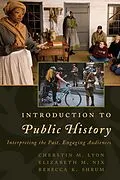Introduction to Public History: Interpreting the Past, Engaging Audiences is a brief foundational textbook for public history. It is organized around the questions and ethical dilemmas that drive public history in a variety of settings, from local community-based projects to international case studies. This book is designed for use in undergraduate and graduate classrooms with future public historians, teachers, and consumers of history in mind.
The authors are practicing public historians who teach history and public history to a mix of undergraduate and graduate students at universities across the United States and in international contexts. This book is based on original research and the authors' first-hand experiences, offering a fresh perspective on the dynamic field of public history based on a decade of consultation with public history educators about what they needed in an introductory textbook. Each chapter introduces a concept or common practice to students, highlighting key terms for student review and for instructor assessment of student learning. The body of each chapter introduces theories, and basic conceptual building blocks intermixed with case studies to illustrate these points. Footnotes credit sources but also serve as breadcrumbs for instructors who might like to assign more in-depth reading for more advanced students or for the purposes of lecture development. Each chapter ends with suggestions for activities that the authors have tried with their own students and suggested readings, books, and websites that can deepen student exposure to the topic.
Autorentext
Cherstin M. Lyon is the director of the honors college and a professor of history at Southern Oregon University. Previously, she coordinated the public and oral history program at California State University, San Bernardino, and served as the university's faculty associate for the Office of Community Engagement. She is author of Prisons and Patriots: Japanese American Wartime Citizenship, Civil Disobedience, and Historical Memory, published by Temple University Press in 2012, and co-editor of Place and Citizenship: Case Studies on the Borders of Citizenship published by Rowman Littlefield International in 2018.
Inhalt
Acknowledgements
Preface
Chapter 1: Introducing Public History
Chapter 2: Thinking Historically
Chapter 3: Interpreting the Past Case Study: The Baltimore '68 Project
Chapter 4: Collecting
Chapter 5: Interpreting and Exhibiting History
Chapter 6: Engaging Audiences
Chapter 7: Engaging Audiences: Case Studies from the Field
Chapter 8: Putting Public History to Work in Your World
